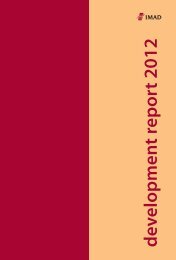You also want an ePaper? Increase the reach of your titles
YUMPU automatically turns print PDFs into web optimized ePapers that Google loves.
IB Revija 1-2/<strong>2011</strong><br />
57<br />
SLOPOL, a macroeconometric model of the<br />
slovenian economy<br />
dr. Klaus Weyerstrass, Institute for Advanced Studies (IHS), Vienna<br />
UDK 338.27 (497.4)<br />
JEL: C510, C540, E370<br />
Povzetek:<br />
Slovenija se je pridružila Evropski uniji <strong>let</strong>a 2004 in je kot prva nova članica vstopila v evrsko območje <strong>let</strong>a 2007. Ker je bila do <strong>let</strong>a<br />
1991 del nekdanje Jugoslavije, se je njena »ekonomska zgodovina« pravzaprav začela šele takrat, kar otežuje prepoznavanje<br />
empiričnih pravil, ki bi lahko bila uporabna pri pripravi napovedi in analiz. Članek predstavlja makroekonometrični model za<br />
Slovenijo, ki se imenuje SLOPOL. Ocenili smo ga s pomočjo najnovejših četrt<strong>let</strong>nih podatkov in temelji na sodobni ekonometrični<br />
metodologiji, ki vključuje analizo stacionarnosti in kointegracije. Model se je že uspešno uporabljal za simulacije alternativnih<br />
ukrepov monetarnih in fiskalnih politik, pa tudi pri pripravi napovedi. V članku je prikazana tudi napoved ekonomskega<br />
razvoja Slovenije za <strong>let</strong>i <strong>2011</strong> in 2012, ki je bila pripravljena na podlagi tega modela.<br />
Ključne besede: Slovenija, makroekonometrični model, ekonomska napoved<br />
Abstract:<br />
Slovenia entered the European Union in 2004 and was the first of the new EU Member States to enter the euro-area in 2007.<br />
As Slovenia was part of the former Yugoslavia until 1991, the economic history of the country to some extent started after<br />
that date. This causes difficulties for research into empirical regularities to be used in forecasting and policy analysis. This<br />
paper describes a macroeconometric model for Slovenia (“SLOPOL”) developed despite these issues. The model uses the most<br />
recent quarterly data and is based on current econometric methodology, including stationarity and cointegration analysis.<br />
The model has already been used successfully for simulations of alternative monetary and fiscal-policy measures, as well as for<br />
forecasting. A forecast of economic development in Slovenia for <strong>2011</strong> and 2012, which was generated with the SLOPOL model,<br />
is also presented in this paper.<br />
Key words: Slovenia, Macroeconometric model, Economic forecast<br />
1. introduction<br />
Decisions about economic policies are characterised<br />
by an increasingly complex environment. Furthermore,<br />
external shocks, such as sudden movements of raw<br />
material prices, exert significant macroeconomic<br />
impacts. While the qualitative effects of demand<br />
and supply shocks, as well as of monetary and fiscal<br />
policy measures can often be derived from economic<br />
theory, their quantification requires a mathematical<br />
representation of the economy. Here, macroeconometric<br />
models containing the most important macroeconomic<br />
aggregates and markets have established a long tradition.<br />
Alongside simulations, macroeconomic models are<br />
regularly used to generate economic forecasts. Hence,<br />
a macroeconometric model that is based on both sound<br />
economic-theoretical considerations and on actual data<br />
is a useful tool for guiding economic policy-making in<br />
Slovenia. This paper describes the history and structure<br />
and an application of SLOPOL, a macroeconometric<br />
model of the Slovenian economy.<br />
In recent years, the SLOPOL model has been used<br />
both for simulation and forecasts. Several simulations<br />
have dealt with identification and quantification of the<br />
macroeconomic effects of the introduction of the euro<br />
in Slovenia in 2007. The incorporated impacts comprised<br />
the transition from an independent monetary policy to<br />
the common monetary policy of the European Central<br />
Bank, and a positive total factor productivity shock due<br />
to saving in transaction costs and an increase of price<br />
transparency with an ensuing increase in competition.<br />
Within the model, the euro-area accession brought about<br />
temporarily higher real GDP growth, a permanently<br />
higher GDP level, more employment, temporarily<br />
lower inflation and a permanently lower price level. On<br />
the other hand, both public finances and the current<br />
account were seen to deteriorate (see, e.g. Weyerstrass<br />
2008, Weyerstrass and Neck 2008a, 2008b).<br />
This paper is structured as follows. In the next section,<br />
the history of the model is sketched. In the third section,

















